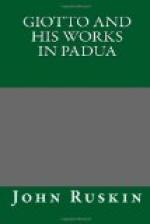no means easy to express
exactly the error,
and
no more than the error, of his original.
In most cases modern copyists try to modify or hide
the weaknesses of the old art,—by which
procedure they very often wholly lose its spirit,
and only half redeem its defects; the results being,
of course, at once false as representations, and intrinsically
valueless. And just as it requires great courage
and skill in an interpreter to speak out honestly
all the rough and rude words of the first speaker,
and to translate deliberately and resolutely, in the
face of attentive men, the expressions of his weakness
or impatience; so it requires at once the utmost courage
and skill in a copyist to trace faithfully the failures
of an imperfect master, in the front of modern criticism,
and against the inborn instincts of his own hand and
eye. And let him do the best he can, he will still
find that the grace and life of his original are continually
flying off like a vapour, while all the faults he
has so diligently copied sit rigidly staring him in
the face,—a terrible
caput mortuum.
It is very necessary that this should be well understood
by the members of the Arundel Society, when they hear
their engravings severely criticised. It is easy
to produce an agreeable engraving by graceful infidelities;
but the entire endeavour of the draughtsmen employed
by this society has been to obtain accurately the
character of the original: and he who never proposes
to himself to rise
above the work he is copying,
must most assuredly often fall beneath it. Such
fall is the inherent and inevitable penalty on all
absolute copyism; and wherever the copy is made with
sincerity, the fall must be endured with patience.
It will never be an utter or a degrading fall; that
is reserved for those who, like vulgar translators,
wilfully quit the hand of their master, and have no
strength of their own.
Lastly. It is especially to be noticed that these
works of Giotto, in common with all others of the
period, are independent of all the inferior sources
of pictorial interest. They never show the slightest
attempt at imitative realisation: they are simple
suggestions of ideas, claiming no regard except for
the inherent value of the thoughts. There is
no filling of the landscape with variety of scenery,
architecture, or incident, as in the works of Benozzo
Gozzoli or Perugino; no wealth of jewellery and gold
spent on the dresses of the figures, as in the delicate
labours of Angelico or Gentile da Fabriano. The
background is never more than a few gloomy masses of
rock, with a tree or two, and perhaps a fountain; the
architecture is merely what is necessary to explain
the scene; the dresses are painted sternly on the
“heroic” principle of Sir Joshua Reynolds—that
drapery is to be “drapery, and nothing more,”—there
is no silk, nor velvet, nor distinguishable material
of any kind: the whole power of the picture is
rested on the three simple essentials of painting—pure
Colour, noble Form, noble Thought.




